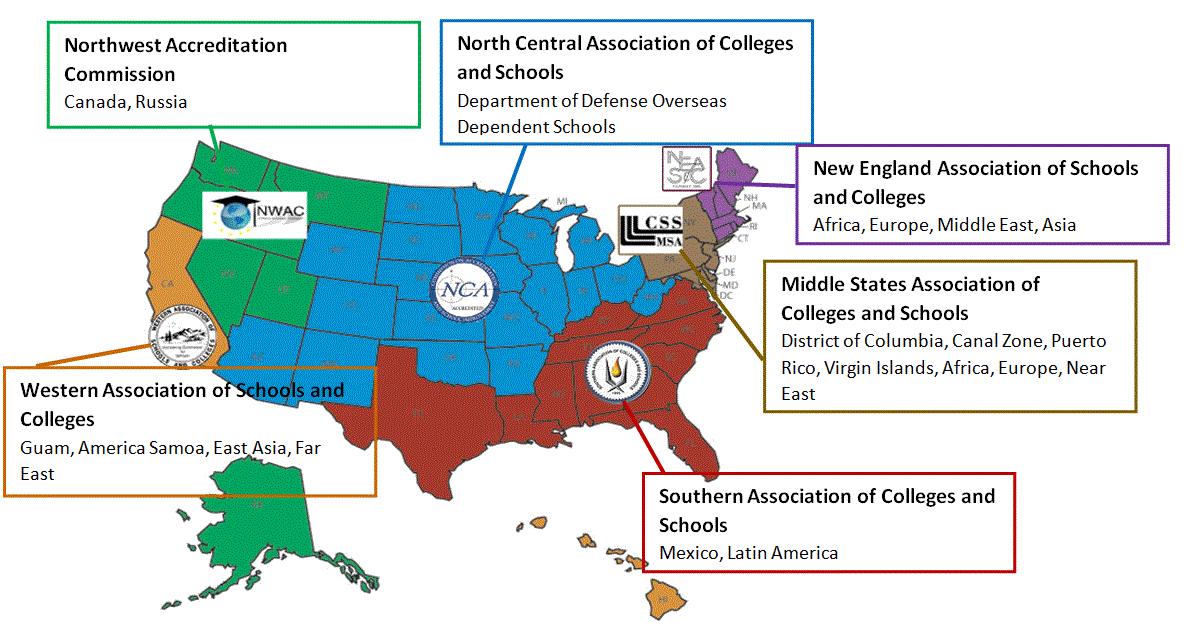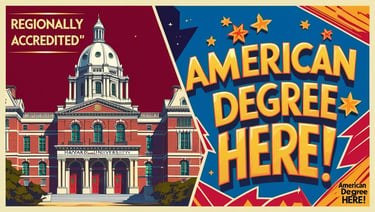Affiliated, Accredited, or Actual — What You Should Know Before Paying for an 'American Degree' from Nepal
Many students in Nepal are paying lakhs for "American degrees" that sound impressive but offer limited global value. This blog breaks down the difference between national vs. regional accreditation, why that matters, and how students can spot red flags. We’ll also introduce affordable, legitimate alternatives that are globally recognized and won’t drain your wallet. Make informed decisions before you enroll.
ASLAT Guidance
7/29/20255 min read
Only Six Real U.S. Accreditors Exist – If Your 'Fancy American Degree' in Nepal Isn't Backed by One, It's Probably Just Expensive Wallpaper
Imagine this: You’re chilling in Kathmandu, scrolling through your phone, and bam! — an ad pops up screaming: “Get an American Degree Without Leaving Nepal!” Stars and stripes, Ivy League fonts, and maybe even a photo of a whiteboard that’s never seen a marker. “Start your degree in Nepal and finish it in the U.S. later,” they say. Sounds tempting, right?
Like it’s some kind of academic layover flight — study 2 years here, then boom, transfer to America. But here’s what they don’t tell you: most U.S. universities don’t accept credits from unaccredited or nationally accredited colleges (which many of these so-called partner schools are). Translation? You’ll likely end up starting over once you get there — or worse, you might not even qualify for transfer at all.
So yeah, it looks smooth on the brochure, but in reality? You could be spending years and a huge chunk of money chasing a dream that collapses the moment you apply for that F-1 visa.
Here’s the twist no one talks about: Many of these “degrees” come with more glitter than global value. Nepali students and parents are pouring in tremendous amounts of money into what’s often just a fancy-looking certificate — with about the same global recognition as a fake pair of Nike Airs from New Road or Yeezy sneakers from a Thamel street shop.
Now for the reality check: In the U.S., there are only six official regional accreditation bodies. If the American college your local institute claims to be “affiliated” with isn’t accredited by one of these six — yep, the ones on that colorful map — then you’ve likely been handed a paper trophy, not a globally respected degree.
So before you sign up and start daydreaming about walking across a stage in a graduation gown (made in Nepal, printed in the U.S.), ask the real question: Is this college actually recognized — or just really good at marketing?
Let’s break it down using this map and help you spot the difference between a degree with real global value and one that’s just wearing a fake label. Because when it comes to your future, you deserve the real thing — not a knockoff.


What Even Is Accreditation? (And Why You Should Care)
Okay, so let’s say degrees are like smartphones. Some are real iPhones straight from the Apple store. Others? Well… they look like iPhones, sound like iPhones, but die after two Instagram stories. That’s where accreditation comes in—it’s the quality-check seal that tells you whether your degree is the real deal or a really expensive knockoff.
Now in the U.S., there are two main flavors of accreditation. Sounds technical? Don’t worry, we’ll break it down with momo-level clarity.
Regional Accreditation: The Gold Standard (a.k.a. the iPhone of degrees)
This is the real VIP stuff. There are only six regional accreditation bodies in the U.S., like NECHE, HLC, WSCUC (don’t worry about the names—they’re just elite clubs). These guys check everything: faculty quality, academic rigor, whether students are actually learning, and even if the cafeteria serves decent coffee (okay, maybe not that last one).
Degrees from regionally accredited universities?
1. Recognized globally
2. Transferable credits
3. Loved by employers, grad schools, and visa officers alike
Want to know who’s got it? Think Harvard, Stanford, NYU—they’re all regionally accredited. So when someone tells you, “Our partner college is just like Harvard,” ask: Regionally accredited, bro?
National Accreditation: Sounds Fancy, But Read the Fine Print
Then we’ve got national accreditation, often handed out to career-focused or online institutions—kind of like fast food: it fills the gap, but you wouldn’t serve it at a wedding.
Sure, it's recognized by the U.S. Department of Education, but here’s the catch:
🚫 Credits usually don’t transfer to regionally accredited schools
🚫 Employers and grad schools (especially abroad) may raise eyebrows
🚫 You could be stuck if you ever want to switch or study further
Agencies like DEAC or ACCSC fall into this category. Some online trade schools have this, and yes—they may still be “American,” but not the kind that opens doors.
Why This Matters in Nepal
Here’s the tea: A bunch of colleges in Nepal claim affiliation with U.S. institutions that are nationally accredited—or worse, not even properly accredited. But they market it like it’s the next best thing to MIT.
💰 Families end up pouring serious money into programs that don’t hold up internationally.
📄 Students get a degree that’s as globally portable as a rock.
🎯 And worst of all, no one tells you the difference until it’s too late.
Real American Degree, Budget Edition: Meet UoPeople
Let’s cut through the glitter and glossy ads for a second.
While some local colleges are out here charging you an arm, leg, and maybe a kidney for a so-called “American degree” (wrapped in red, white, and confusion), University of the People (UoPeople) is just... chilling online, offering the real deal for under $5,000 total. Yep, you read that right — not per semester, not per year, but for the entire 4-year bachelor’s degree.
Here’s how it works: UoPeople is tuition-free — no expensive buildings, no fountains with swans, and definitely no campus tour with a Starbucks gift card. You just pay $120 per course as an “assessment fee” — kind of like paying to take the exam. Multiply that by around 40 courses, and boom: you get a legit, regionally accredited U.S. degree for about $4,800.
Oh, and did we mention? As of February 2025, UoPeople is officially regionally accredited by WASC (WSCUC) — the same body that accredits traditional U.S. universities like CalTech and Stanford. So yeah, no more “Is this degree real?” side-eyes from embassies or employers.
Moral of the story? While others are busy giving you certificates with more drama than value, UoPeople gives you a degree that actually holds weight—without making you sell your bike or your dreams.
Don’t Just Study Abroad—Study Smart
At the end of the day, it’s not about chasing fancy names or foreign logos. It’s about making sure your degree opens real doors — for jobs, visas, grad school, and beyond. So take a breath, ask the right questions, and don’t fall for degrees that look global but live local. Your career deserves more than a knockoff label. Let’s help you find the real thing.
The right degree can change your future—but only if it's recognized and respected. Don’t let clever marketing drain your wallet or delay your dreams. There are smarter, more affordable, and globally accepted options out there—like University of the People.
Final Word: Choose Value, Not Just a Label
If you’re currently enrolled—or thinking about enrolling—in a so-called “American degree” program in Nepal, take a step back and do your homework. Many of these programs might look shiny on the outside but fall short where it matters most: global recognition.
Want the real deal? Check out UoPeople.edu — a regionally accredited U.S. university offering globally respected degrees for a fraction of the cost. No fake promises. No flashy gimmicks. Just legit education that travels.
And if you're serious about studying abroad the right way, we're here to guide you.
🌐 Visit: ASLATGuidance.com
🎓 Real guidance. Real results. Real future.


Support
Expert guidance for studying in the U.S.
📅 Consultation
Resources
✉️ team@aslatguidance.com
📞+977 970-105-1182
© 2025. All rights reserved.
📞+1 405-471-8436
📍ALE COMPLEX, 2ND FLOOR
Boudha - Jorpati Rd, Gokarneshwor - 06
Boudha, Kathmandu, Nepal 44600
🌐 Serving Students Across Nepal
✉️ relations@aslatguidance.com
